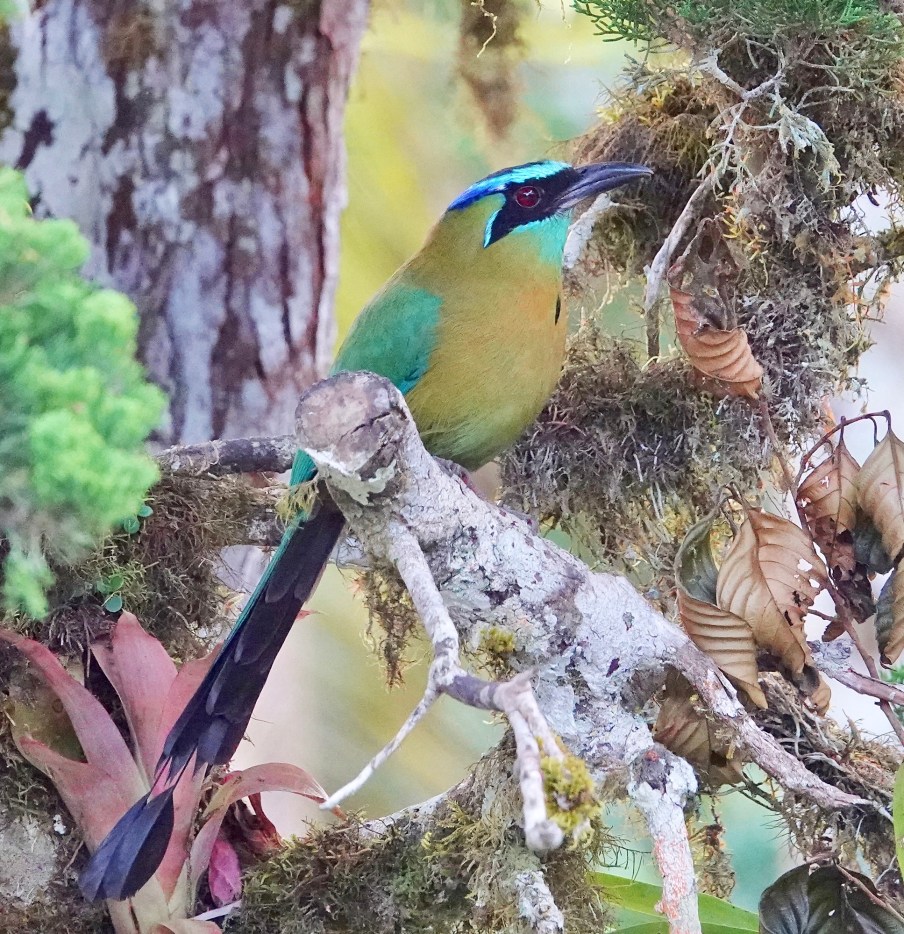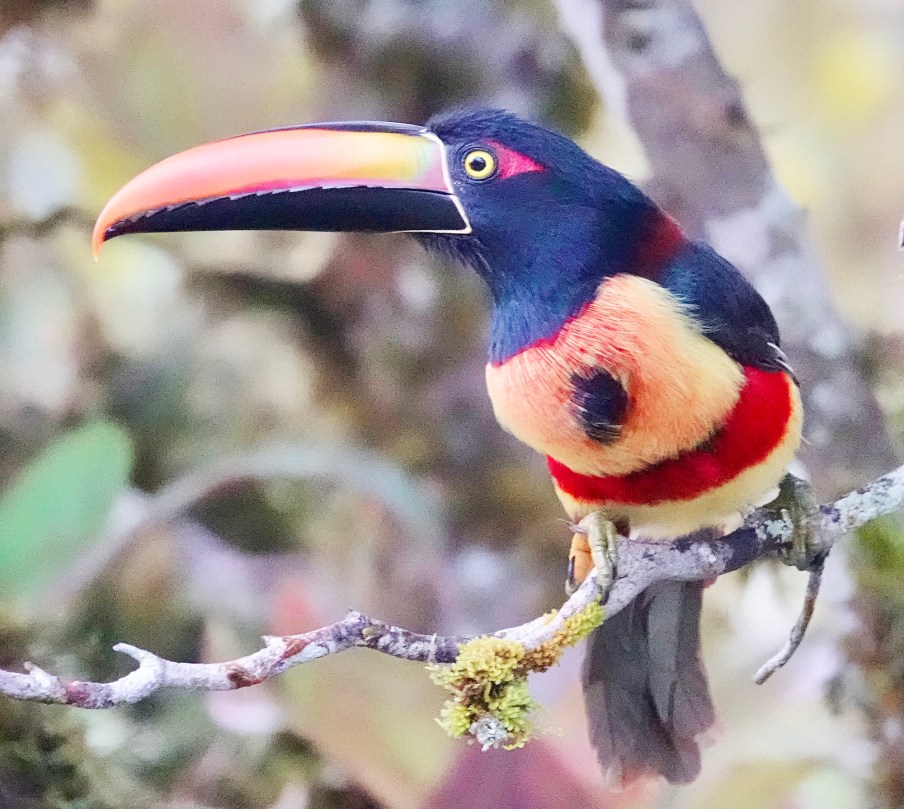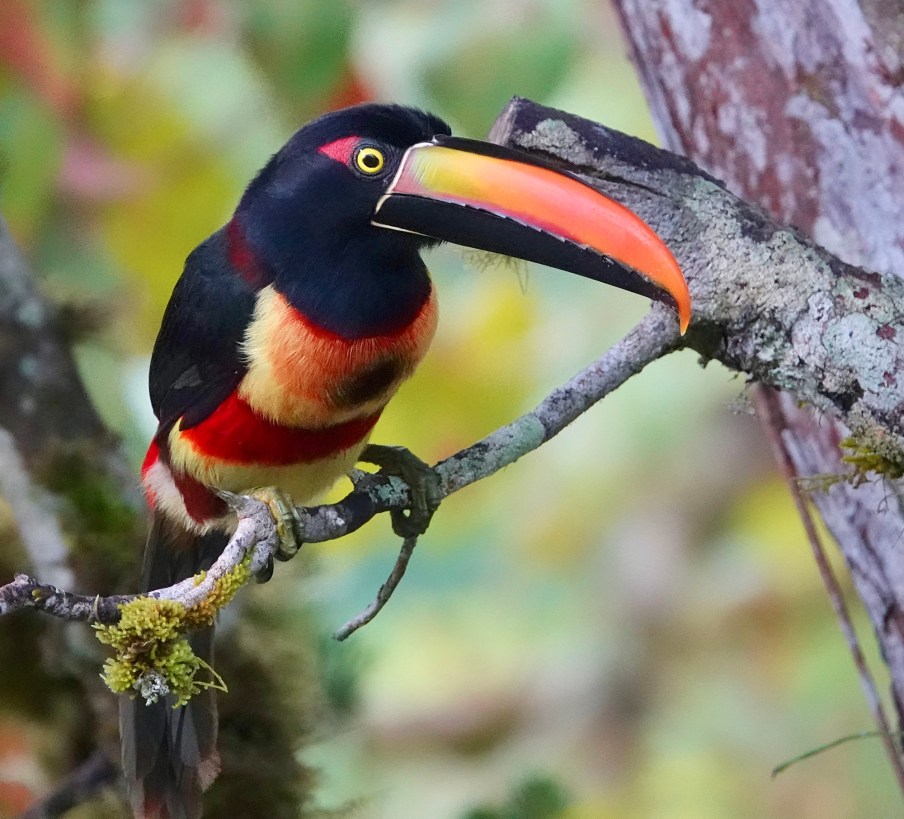Posts in Category: Costa Rica
Lesson’s Motmot


Lesson’s Motmot: Las Cruces Biological Research Station (OTS), San Vito, Costa Rica — Checking my field guide, I see that the Lesson’s Motmot, which it seems to me is the most common Central American Motmot, is also the only Motmot resident on the southern Pacific slope of Costa Rica. This bird came to the bananas on the patio of the dining hall at Las Curces whenever we put them out. Certainly a handsome bird. Sony Rx10iv at 330mm and 600mm equivalent. Program mode with wildlife modifications and multi-frame noise reduction. Processed in Pixelmator Photo and Apple Photos. Equivalent ISO 2500 and 3200 @ f4 @ 1/500th.
White-crowned Parrot

White-crowned Parrot: Las Curces Biological Research Station (OTS), San Vito, Costa Rica — I am not sure why the number of different Parrot species we were seeing at Las Cruces did not register at the time. As I go back through my photos from our few days there, I am amazed to keep finding new parrots. It is almost as much fun as being there was! This is the White-crowned Parrot. I had seen White-fronted Parrots in Honduras, and maybe had them confused in my mind, but I am pretty sure this was a life bird at the Wilson Botanical Gardens at Las Curces. Not the best encounter…distant and behind some foreground palm fonds, and against the light…but still! We had better sightings later (which you will probably see in a few days 🙂 Sony Rx10iv at 600mm equivalent (cropped and enlarged to maybe 1800mm or more). Program mode with my custom birds and wildlife modifications. Processed in Pixomator Photo and Apple Photos. ISO 200 @ f4 @ 1/500th. +1.7 EV for the backlight.
Lily: Happy Easter

For Easter morning, a Lily from the Wilson Botanical Gardens at the Las Cruces Biological Research Station in San Vito, Costa Rica. We spent a December morning exploring the extensive gardens with a local guide. Sony Rx10iv at 600mm equivalent. Program mode with my custom birds and wildlife modifications. Processed in Pixelmator Photo and Apple Photos. ISO 100 @ f4 @ 1/500th.
Crested Guan

Crested Guan: Las Cruces Biological Research Station (OTS), San Vito, Costa Rica — Guans are hard to miss, if they are around at all. They are huge. Even the Black Guan of higher elevations is big, and the Crested Guan is the size of a turkey. In fact they remind me a lot of a turkey. And Crested Guans, like turkeys, seem to like yards and gardens, openings, clearings, where they are easy to see. We see them at La Selva Biological Station in the Sarapique valley in the Caribbean lowlands, and we found this one in the Wilson Botanical Gardens in the foothills of the Pacific slope. Sony Rx10iv at 600mm equivalent. Program mode with my custom birds and wildlife modifications. Processed in Pixomator Photo and Apple Photos. ISO 100 @ f4 @ 1/800th.
Brown-hooded Parrots

Brown-hooded Parrots: Las Cruces Biological Research Station (OTS), San Vito, Costa Rica — In hindsight, our December trip to the Osa Peninsula, Las Cruces, and Savegre was highly productive in parrots…several of whom we encountered in and around the Wilson Botanical Gardens. These two were posed against the light and at a good distance, but, with some work in Pixomator Photo, it still at least a good record shot. Sony Rx10iv at 600mm equivalent. Program mode with my custom birds and wildlife modifications. Processed as above in Pixomator Photo and Apple Photos. ISO 100 @ f5 @ 1/1000th.
Yellow-crowned Euphonia


Yellow-crowned Euphonia: Las Cruces Biological Research Station (OTS), San Vito, Costa Rica — The Euphonias are named, of course, for their melodious songs and calls. There are several in Costa Rica and though the Yellow-crowned is preset on the Caribbean slope, I had to wait until I was in the foothills on the Pacific slope to see one. This bird came to the bananas we put out on the terrace at the dinning hall at the Wilson Botanical Gardens. It is certainly a perky, attractive little bird. Sony Rx10iv at 600mm equivalent. Program mode with wildlife modifications and multi-frame noise reduction. Processed in Pixomator Photo and Apple Photos. Equivalent ISO 2000 @ f4 @ 1/500th.
Golden-hooded Tanager


Golden-hooded Tanager: Las Cruces Biological Research Station (OTS), San Vito, Costa Rica — The Golden-hooded Tanager is another example of the bright tanagers of Central America. It is common on both Caribbean and Pacific slopes from lowlands up into the foothills, where we saw this one at the Wilson Botanical Gardens. The combination of colors on this bird is certainly eye-catching. Sony Rx10iv at 600mm equivalent. Program mode with wildlife modifications and multi-frame noise reduction. Processed in Pixelmator Photo and Apple Photos. Equivalent ISO 3200 and 1600 @ f4 @ 1/500th.
Speckled Tanager



Speckled Tanager: Las Cruces Billogical Station, San Vito, Costa Rica — The tanagers of Central America and South America are among the most colorful of birds. This Speckled Tanager was a life bird for me at the Wilson Botanical Gardens, and an instant favorite. It has a restricted range, not geographically…it is found from Costa Rica south into northern South America, but only at a particular altitude in the foothills of the mountains. It is not uncommon where it lives, but you have to be where it lives. Which is one of the reasons I enjoyed Las Cruces Biological Station and the Wilson Gardens so much…it was my first extended stay in at foothill elevations, and we got to see quite a few new birds, for me, in Costa Rica. Sony Rx10iv at 554mm equivalent. Program mode with wildlife modifications and multi-frame noise reduction. Processed in Pixelmator Photo and Apple Photos. Equivalent ISO 3200 @ f4 @ 1/500th.
Fiery-billed Aracari



Fiery-billed Aracari: Las Cruces Biological Research Station (OTS), San Vito, Costa Rica — We saw our first Fiery-billed Aracari at Danta Corcovado Lodge, but it was high in a tree from the observation platform, and I could not get the kind of photo that I wanted. The Fiery-billed Aracari is a common bird with a limited range…restricted to the lowland forests and foothills of the Pacific slope of Costa Rica and Panama. Like all toucans, its love of bananas brings it to feeding stations, even the intermittent one at the Organization for Tropical Studies Las Cruces Biological Station. Edwin, our guide, went into town our first night there to buy bananas to stock the feeders off the patio outside the dinning hall just for us, and we were there at first light, before breakfast, to see what birds would come. The Fiery-billed Aracari was an early arrival. For a lover of birds and photography, it does not get any better than this (though we can always hope for better light). Sony Rx10iv at 400-550mm equivalent. Program mode with wildlife modifications and multi-frame noise reduction. Processed in Pixelmator Photo and Apple Photos. Equivalent ISO 4000 and 6400 @ f4 @ 1/320, 1/250, and 1/500.
Panama Flycatcher? (in Costa Rica)

Panama Flycatcher?: Calla de Gambia, Golfito, Costa Rica — Our brief visit to Calla de Gambia was certainly productive. This is, I am thinking, a Panama Flycatcher, a bird that, despite its name, has most of its range in northern South America, coming up into Panama on both coasts and limited to the a thin band on very edge of the Pacific coast in Costa Rica. It could be, however, a Great Crested Flycatcher. The photo was taken through the glass on our bus, and I had to adjust the color to compensate. Even so, I would expect a sharper division on the chest and a darker yellow on the belly in a Great Crested. ??? Still thinking Panama. 🙂 If anyone has a better idea let me know. Sony Rx10iv at 600mm equivalent. Program mode with my custom birds and wildlife modifications. Processed in Pixelmator Photo and Apple Photos. ISO 100 @ f4 @ 1/500th.